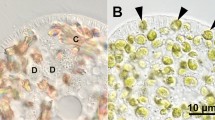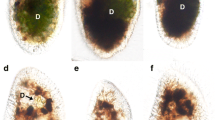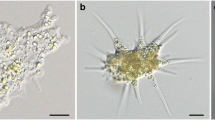Summary.
Paramecium bursaria free of symbiotic Chlorella species can be experimentally reinfected with algae isolated from algae-bearing cells by ingestion into digestive vacuoles. Isolated symbiotic algae were cloned, mixed with the algae-free P. bursaria at 25 ± 1 °C for 1.5 min, washed and chased, with or without fixation 3 h after mixing. Though genetically identical, a few of the algae were not digested but coexisted with the digested ones in the same vacuole after lysosomal fusion. Light microscopy showed that algal fate did not depend on cell cycle stage or location in the vacuole. Electron microscopy showed that the nondigested algae were not protected by a perialgal vacuole membrane in the digestive vacuole. Moreover, this phenomenon was also observed in the presence of cycloheximide and puromycin, which are known to inhibit algal and host protein synthesis, respectively. These observations suggest that a few algae can acquire temporary resistance to host lysosomal enzymes in order to establish endosymbiosis without algal protein synthesis.
Similar content being viewed by others
Abbreviations
- DIC:
-
differential-interference contrast
- DV:
-
digestive vacuole
- PV:
-
perialgal vacuole
- SDC:
-
single digested Chlorella sp.
- SGC:
-
single green Chlorella sp.
- TEM:
-
transmission electron microscope
References
A Ayala DS Weis (1987) ArticleTitleThe effect of puromycin and cycloheximide on the infection of algae-free Paramecium bursaria by symbiotic Chlorella J Protozool 34 377–381 Occurrence Handle1:CAS:528:DyaL1cXhvFWnug%3D%3D
S Dryl (1959) ArticleTitleAntigenic transformation in Paramecium aurelia after homologous antiserum treatment during autogamy and conjugation J Protozool 6 IssueIDSuppl 25
BI Gerashchenko N Nishihara T Ohara H Tosuji T Kosaka H Hosoya (2000) ArticleTitleFlow cytometry as a strategy to study the endosymbiosis of algae in Paramecium bursaria Cytometry 41 209–215 Occurrence Handle11042618 Occurrence Handle10.1002/1097-0320(20001101)41:3<209::AID-CYTO8>3.0.CO;2-U Occurrence Handle1:STN:280:DC%2BD3M%2FlvFGgsw%3D%3D
FK Gu L Chen B Ni X Zhang (2002) ArticleTitleA comparative study on the electron microscopic enzymo-cytochemistry of Paramecium bursaria from light and dark cultures Eur J Protistol 38 267–278 Occurrence Handle10.1078/0932-4739-00875
K Hiwatashi (1968) ArticleTitleDetermination and inheritance of mating type in Paramecium caudatum Genetics 58 373–386 Occurrence Handle5662626 Occurrence Handle1:STN:280:CCeA38fotlU%3D
T Ichimura M Watanabe (1974) ArticleTitleThe Closterium calosporum complex from the Ryukyu Islands: variation and taxonomical problems Mem Nat Sci Mus Tokyo 7 89–102
MW Karakashian (1975) ArticleTitleSymbiosis in Paramecium bursaria Symp Soc Exp Biol 29 145–173 Occurrence Handle785659
SJ Karakashian (1963) ArticleTitleGrowth of Paramecium bursaria as influenced by the presence of algal symbionts Physiol Zool 36 52–68
SJ Karakashian MA Rudzinska (1981) ArticleTitleInhibition of lysosomal fusion with symbiont-containing vacuoles in Paramecium bursaria Exp Cell Res 131 387–393 Occurrence Handle7202538 Occurrence Handle10.1016/0014-4827(81)90242-1 Occurrence Handle1:STN:280:Bi6C3sfkvFI%3D
Y Kodama M Fujishima (2005) ArticleTitleSymbiotic Chlorella sp. of the ciliate Paramecium bursaria do not prevent acidification and lysosomal fusion of the host digestive vacuoles during infection Protoplasma 225 191–203 Occurrence Handle15997335 Occurrence Handle10.1007/s00709-005-0087-5
M Nakahara S Handa T Nakano H Deguchi (2003) ArticleTitleCulture and pyrenoid structure of a symbiotic Chlorella species isolated from Paramecium bursaria Symbiosis 34 203–214
N Nishihara M Murata-Hori T Yamada T Kosaka H Hosoya (1999) ArticleTitleCharacteristic variation of cloned endosymbiotic algae in Paramecium bursaria Jpn J Protozool 32 31
W Reisser W Wiessner (1984) Autotrophic eukaryotic freshwater symbionts HF Linkens J Heslop-Harrison (Eds) Cellular interactions SeriesTitleEncyclopedia of plant physiology, new series NumberInSeries17 Springer Berlin Heidelberg New York 59–74
W Reisser S Vietze M Widowski (1988) ArticleTitleTaxonomic studies on endocytobiotic chlorophycean algae isolated from different American and European strains of Paramecium bursaria Symbiosis 6 253–270
H Takeda T Sekiguchi S Nunokawa I Usuki (1998) ArticleTitleSpecies-specificity of Chlorella for establishment of symbiotic association with Paramecium bursaria – Does infectivity depend upon sugar components of the cell wall? Eur J Protistol 34 133–137
DS Weis (1984) ArticleTitleThe effect of accumulated time of separate cultivation on the frequency of infection of aposymbiotic ciliates by symbiotic algae in Paramecium bursaria J Protozool 31 13A
Author information
Authors and Affiliations
Corresponding author
Additional information
Correspondence and reprints: Biological Institute, Faculty of Science, Yamaguchi University, Yoshida 1677-1, Yamaguchi 753-8512, Japan.
Rights and permissions
About this article
Cite this article
Kodama, Y., Nakahara, M. & Fujishima, M. Symbiotic alga Chlorella vulgaris of the ciliate Paramecium bursaria shows temporary resistance to host lysosomal enzymes during the early infection process. Protoplasma 230, 61–67 (2007). https://doi.org/10.1007/s00709-006-0193-z
Received:
Accepted:
Published:
Issue Date:
DOI: https://doi.org/10.1007/s00709-006-0193-z




